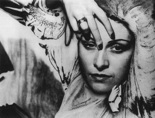
Dora Maar led an extraordinary life stretching the length of the twentieth century, and shared a crucial period of it with its most prominent artist, Pablo Picasso. But she was a remarkable personality in her own right, a brilliant intellectual and muse of the Surrealists in the Paris of the 1930’s, she was also a talented photographer and painter, the full extent of which was not recognised until an entire unseen body of work was discovered in her apartment after her death in 1997, bringing to light her extraordinary breadth of creativity, from fashion and advertising photography, to social documentary, and political activism with André Breton’s “Contre-Attaque” and “Groupe Octobre”.
Born Henriette Theodora Markovitch in 1907, Maar had a Croatian father who was a successful architect and when she was three his work took the family to Buenos Aires where they lived until 1926. Upon her return to Paris she studied photography and frequented the Académie Julian and André Lhote’s studio. In the early thirties she shared a studio with Brassaï, and began to establish a reputation for her photography, as well as participating in socio-political activism, not least during the Spanish civil war. She also met André Breton and started to participate in the Surrealist group’s activities, regularly exhibiting with them, including at the Museum of Modern Art in New York in 1936. That same year, the 29 year old Maar first encountered the then 55 year old Picasso. Over the next few years they became lovers and Maar intimately witnessed his turbulent creativity, she was the only person Picasso allowed to see and record all the successive stages of his monumental “Guernica”.
Although initially Maar was undoubtedly intoxicated by Picasso’s artistic stature, in the years after their love affair cruelly ended in 1943 she struggled with mental health. However, she went on to develop a powerful abstract style of her own, evolving from the post-cubist paintings, to gestural abstract landscape works, and in the late 1960’s her dazzling geometric paintings. Created by flat surfaces of vibrant colour, these paintings are instilled with great vitality through the dynamic lineal divisions, in the tradition of the “Simultaneous Contrasts” of Delaunay. What Picasso did with a mandolin, a fruit-bowl or the human figure, Maar did with light itself, cutting it up and piecing it together again in a new way.
Maar exhibited at prominent Parisian galleries such as Jeanne Bucher, Denise René, Pierre Loeb, and René Drouin, and group shows with Villon, Mannessier, Atlan and Dubuffet amongst others; as well as abroad including at the Leicester Galleries in London in 1958. In her later years she returned to photography using experimental techniques, but lived a reclusive life and her work remained at her home at 6 rue de Savoie, in Paris, unseen by anyone. Only after her death in 1997 has the full extent of her talent come to light.
A major exhibition of her work is being held at the Centre Pompidou in 2019, traveling on to Tate Modern, and the Getty Center LA in 2020.